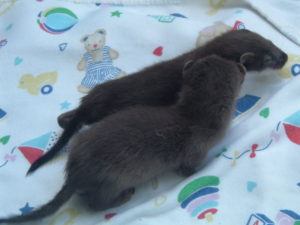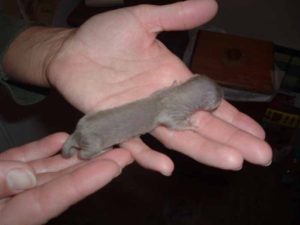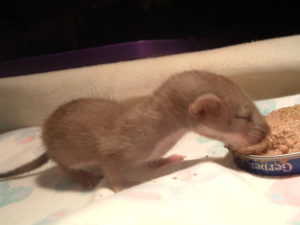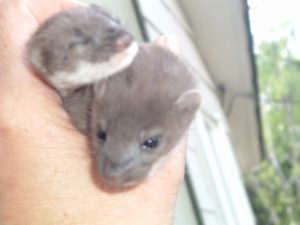The telephone rings and I instinctively cringe. It is mid May and around dusk. The voice on the other end says” “We found a fawn in our yard this afternoon so we brought it in and have been feeding it”
I ask “Why did you bring it in?”
“Because it is cold out and it was all alone and we couldn’t see its mother”
“What did you feed it?”
“We got a baby bottle and gave it some milk” He says proudly
“Cows milk?” I say as my blood pressure starts to rise
“Is there any other kind of milk?” He snaps
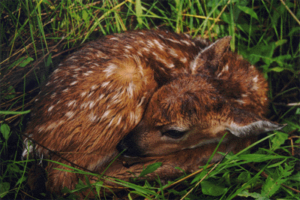 I am getting pretty irritated but try to stay civil “Well, yes, there is mothers milk, which is what the baby needs, not cows milk. He is not a cow, he is a fawn and he needs his mothers milk. Cows milk will make a fawn very ill and could kill him. When you found the fawn, was he injured, laying flat or was he curled up?” I ask.
I am getting pretty irritated but try to stay civil “Well, yes, there is mothers milk, which is what the baby needs, not cows milk. He is not a cow, he is a fawn and he needs his mothers milk. Cows milk will make a fawn very ill and could kill him. When you found the fawn, was he injured, laying flat or was he curled up?” I ask.
“He was curled up in the front yard. We found him about 2:00 PM and brought him in. it is cold out there. What should we be feeding him?”
I take a deep breath, because I will once again go through the process of explaining fawn behavior and how does protect their young. I am mildly irritated by the fact that an obviously elderly couple could not have ever heard about how not to interfere with wildlife and that it is completely normal for fawns to be lying outside by themselves – even in cold weather, even in ones front yard….
“When a doe has a fawn, the fawn is too young to travel with its mother. It can’t run, so the best protection against predators is to lie very still, since predators hunt by movement. The doe lays her young fawn down and tells it to stay there. She then leaves. It may be your front yard, back yard or doorstep. They do not stay by their babies like humans do, or like many of the domestic animals that we know about, such as cows and horses do.
The does leave the area so as not to attract predators to the spot where the baby is. They are watching though. The does will come back just after dark, feed and tend the baby and move it a bit, sometimes only a few feet, then lay it down again. How much the fawn is moved will usually depend on the age of the fawn and the ability to travel with mom. Once the baby is two to three weeks old, its ability to run is greater and its reaction may be to get up and run, rather than lie still.
People often expect that if they approach the fawn the doe will come charging out and try to keep them away. Not so. The does are hoping the human will react like most other predators, not notice the baby and leave. Unfortunately, many times if a human finds a fawn, they do not leave, they assume the baby is an orphan and take it (kidnap it). Imagine the mothers distress. So, just because you do not see the doe, does not mean she has abandoned her fawn. Does and other wild animals do not abandon their babies! They are very good, devoted mothers. Different wild animals protect their babies in different ways. Deer and Rabbits protect their young by NOT being there and only coming back to tend the baby when there is no one around and / or after dark. So, if you are standing there by the baby outside, I can guarantee that the mother will not be seen as long as you are in the area. To the deer or rabbit you are a predator.
At this time, I would like to dispel a common myth that we were all told as kids… “Don’t touch baby wild animals because their mother will smell your scent on them and will abandon them”. Guess what? Not True! This is nothing but a common wives tale. They don’t care that your scent is on their babies, after all, they are familiar with human scent because it is all over the area and on everything. They felt secure enough to have their babies nearby all that human scent. They don’t care that human scent is on their babies – the mothers instinct is much stronger than the fear of human scent. This goes for baby birds, baby bunnies, baby everything and of course, fawns. This is NOT permission to touch wild animal babies though. It just means if you made a mistake and touched it, its mother will still take it back. A doe will take her fawn back as much as 48 hours after it was kidnapped by humans. The only reason it might not be able to be reunited in many instances is because the humans fed it cows milk or something other than it’s own mothers milk. I have successfully reunited fawns that were kept overnight, handled, licked by dogs, etc.. Momma was there within minutes of the return.
There are certainly circumstances that require rescue rather than reuniting. If you can see blood, open wounds, exposed bones or other injuries. Green Flies sitting on the fawn are an indicator of an injury too. If the fawn was hit by a car, if a leg or legs appear damaged, if it is caught in a fence or trap or has been attacked by a predator. If the fawn has been held for days by a finder or fed the wrong foods by a finder(cows milk is a big No NO!). If the fawn is having trouble breathing or is unconscious. If a fawn has been walking around and bleating for more than a few hours this may indicate trouble. If a dead doe is near the fawn.
A healthy fawn lays curled up and very still. If disturbed, a healthy fawn may get up and walk around bleating . The fawns bleat sounds like “mmma”. If you have mistakenly disturbed the fawn, leave the area immediately. Let it lay back down somewhere and stay out of the area. Keep pets and children away. If you call around for information from a rehabilitator or other animal control person, please beware of anyone who does not ask questions and just says” we will come get it”. Any rehabilitator or animal professional worth salt will ask a lot of questions about the fawn, how it was found, what it was doing, etc.. ” don’t allow someone to just take the fawn unless it has been truly determined that it is necessary. Fawns do much better when raised by their mommas. They can avoid hunters the best in the fall and really need to be raised by their mothers, not humans.
Simply being in a populated area is NOT reason to take a fawn. Occasionally we have taken fawns that were found by humans out of public parks on Memorial Day Weekend. We bring them back to the center and keep them until dusk when the park closes or human activity subsides that day. We then take the baby back around dusk to the spot where it was discovered and put it back so its mother can take it and hopefully move it to a better location.
There is a wide window of opportunity to return a kidnapped fawn. Many people believe coyotes are the single greatest threat to fawns. Not so. it is humans . It is humans who do not understand the behavior of wildlife.

